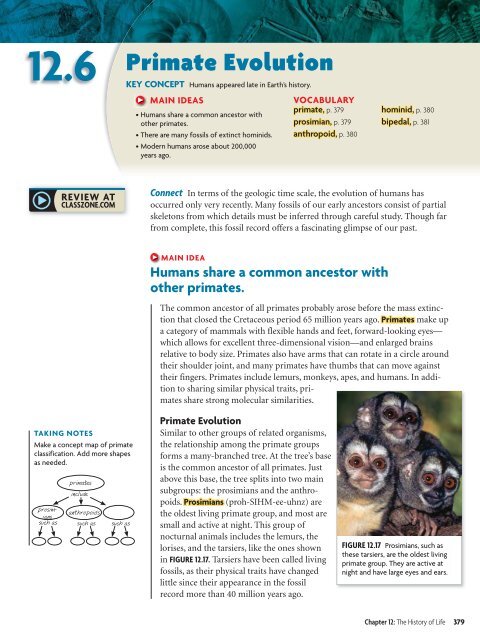12 The History of Life
12 The History of Life
12 The History of Life
- No tags were found...
You also want an ePaper? Increase the reach of your titles
YUMPU automatically turns print PDFs into web optimized ePapers that Google loves.
<strong>12</strong>.6Primate EvolutionKEY CONCEPT Humans appeared late in Earth’s history.MAIN IDEAS• Humans share a common ancestor withother primates.• <strong>The</strong>re are many fossils <strong>of</strong> extinct hominids.• Modern humans arose about 200,000years ago.VOCABULARYprimate, p. 379prosimian, p. 379anthropoid, p. 380hominid, p. 380bipedal, p. 381Connect In terms <strong>of</strong> the geologic time scale, the evolution <strong>of</strong> humans hasoccurred only very recently. Many fossils <strong>of</strong> our early ancestors consist <strong>of</strong> partialskeletons from which details must be inferred through careful study. Though farfrom complete, this fossil record <strong>of</strong>fers a fascinating glimpse <strong>of</strong> our past.MAIN IDEAHumans share a common ancestor withother primates.<strong>The</strong> common ancestor <strong>of</strong> all primates probably arose before the mass extinctionthat closed the Cretaceous period 65 million years ago. Primates make upa category <strong>of</strong> mammals with flexible hands and feet, forward-looking eyes—which allows for excellent three-dimensional vision—and enlarged brainsrelative to body size. Primates also have arms that can rotate in a circle aroundtheir shoulder joint, and many primates have thumbs that can move againsttheir fingers. Primates include lemurs, monkeys, apes, and humans. In additionto sharing similar physical traits, primatesshare strong molecular similarities.TAKING NOTESMake a concept map <strong>of</strong> primateclassification. Add more shapesas needed.primatesincludeprosimiansanthropoidssuch as such as such asPrimate EvolutionSimilar to other groups <strong>of</strong> related organisms,the relationship among the primate groupsforms a many-branched tree. At the tree’s baseis the common ancestor <strong>of</strong> all primates. Justabove this base, the tree splits into two mainsubgroups: the prosimians and the anthropoids.Prosimians (proh-SIHM-ee-uhnz) arethe oldest living primate group, and most aresmall and active at night. This group <strong>of</strong>nocturnal animals includes the lemurs, thelorises, and the tarsiers, like the ones shownin FIGURE <strong>12</strong>.17. Tarsiers have been called livingfossils, as their physical traits have changedlittle since their appearance in the fossilrecord more than 40 million years ago.FIGURE <strong>12</strong>.17 Prosimians, such asthese tarsiers, are the oldest livingprimate group. <strong>The</strong>y are active atnight and have large eyes and ears.Chapter <strong>12</strong>: <strong>The</strong> <strong>History</strong> <strong>of</strong> <strong>Life</strong> 379

















